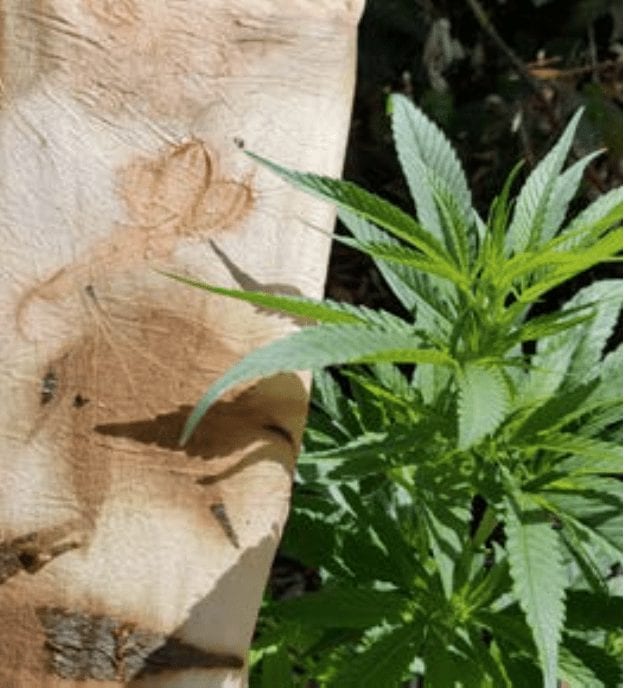
Local Textile Artist Innovating Her Craft with Cannabis and Flora
”The cannabis leaf is a ubiquitous symbol of the community and the industry, but its seeming uniformity is a misnomer.”
 A walk along the Eel River as it moves west past Fortuna, California gives a glimpse of the biodiversity of Humboldt. There are many ways of capturing a moment during a hike — photographers frame a shot, painters interpret the landscape on canvas and others like Autumn Glock carefully collect leaves and flowers for an art known as eco-printing.
A walk along the Eel River as it moves west past Fortuna, California gives a glimpse of the biodiversity of Humboldt. There are many ways of capturing a moment during a hike — photographers frame a shot, painters interpret the landscape on canvas and others like Autumn Glock carefully collect leaves and flowers for an art known as eco-printing.
Eco-printing takes natural materials such as leaves and flowers to dye and print on fabrics, and Autumn has been experimenting with this craft for decades. As she picks her way along the riverbank, she selects from among the landscape’s healthy greens like fennel, grasses, blackberry leaves, and cottonwood leaves before heading home to her studio. Once there, she sorts through the leaves individually, and chooses several to imprint a cotton scarf with their beautiful yet unpredictable colors through a natural chemical process. The final product? A locally sourced scarf representing the flora the Eel River had to offer that day.
River walk excursions bring together an array of leaves and colors to fabrics, but Autumn especially enjoys hunting for tantalizing leaves in cannabis gardens. The cannabis leaf is a ubiquitous symbol of the community and the industry, but its seeming uniformity is a misnomer. Browsing the silk, cotton and wool scarves in her collection, the variety is clearly visible across these pieces in the shapes and hues these different leaves impart.
“I enjoy doing eco-printing with cannabis because it’s sustainable for this region,” she said. “Though the word ‘sustainable’ can be interpreted in a lot of different ways in the textile world.”
Sustainability is a major factor in Autumn’s eco-printing art, and she strives to be as eco-friendly as possible. She exhaustively researches new methods of dyeing, printing and follows major textile figures from around the world. Innovative eco-printer India Flint from Australia is a major influence on Autumn’s work; Flint suggests in her writing that silk shouldn’t be used for eco-printing because it’s unsustainable.
But that is only one way to think about being sustainable, Autumn said. While the production of silk may be unsustainable when compared to cotton or wool, she sees eco-printing as an environmentally-friendly way that people can revitalize tired clothes or make a thrift shop find a unique piece.
Almost no textile artists are working with cannabis and hemp plants, so the scarves, dresses and gloves Autumn makes are unique to the Emerald Triangle. But she would like to show others with easy access to leaves how they can modify their own wardrobes. Farmers and farm workers could also take advantage of this cannabis byproduct to modify their own clothes right on the hill with a little prep. She plans to start offering workshops on her techniques because “I want people who are trimming and people who grow to be able to do this,” she said.
How Does Eco-Printing Work?
Horticulturist and artist Susan Ernst offers a succinct description of eco-printing: “nature printing with steam.” The basic  process looks like this:
process looks like this:
- Gather healthy leaves and flowers
- Arrange the flora on silk, wool, cotton, hemp or linen.
- Wrap the fabric around an iron pipe; tie tightly.
- Soak and steam fabric with water.
The iron pipe acts as a mordant, which is what causes the leaves and flowers to react and dye their shapes into the fabric. The result is never exactly the same, even with leaves from similar source material. Autumn said she has noticed that even the type of iron pipe she uses can make a big difference.
While eco-printing at its basic level isn’t difficult, the experimentation and creativity required for realizing a specific vision is significant. Autumn combines her knowledge of natural dyes, yarn-making and eco-printing to produce multiple colors (not an easy feat with natural
dyes) in sophisticated tones that incorporate cannabis leaves and other themed flora. Eco-printed art is often intended to reflect the region of its source materials.
Australian eco-printer Flint describes her own work as “the earth as the printing plate and time as the press.”
Foraging Tips
- Only take 10% or less of flora from any area
- Wear gloves and leg coverings
- No foraging in state or national parks
What color does cannabis dye fabric? Yellow.
Refining Natural Techniques
To say Autumn has a passion for textiles is to weave an incomplete mural. Continuously trying new techniques, she first delved into natural dyeing at nine years old and continues to plow through every textile class and book she can manage, always eager to glean a new idea or tip to perfect her craft. She is writing an eco-printing book that will reflect her experiences working with cannabis and other natural elements.
Written by Allison Edrington



Leave a Reply